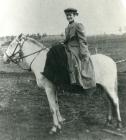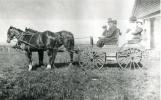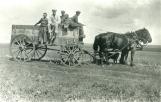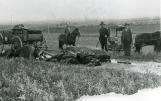2
Two Ladies Riding HorsebackThis was a main mode of travel for the early settlers, both for enjoyment, and for necessary travel, as there were not many roads as yet, only horse trails and wild prairie to travel over.
As well as horseback, the early settlers travelled in horse-drawn wagons, buggies, sleighs and carts.
4
Percy Bromley on Horseback in the early 20'sPercy arrived in the Tees area (near Mirror) with his parents, Henry and Eleanor, a brother, Roy and two sisters, Marjorie and Rosemary on October 20, 1912 from England.
The Bromley's filed on the last homestead available in the Gadsby Lake district in 1913, building a log home and living off the land.
Percy eventually married Miss Edith Witt, and moved to Flatbush Alberta
6
Mrs E.E. (Frances) Mallot riding SidesaddleFrances met her husband, Everett in 1905, on a visit from Montreal to her parents homestead in the Mirror area. She married Everett on March 28, 1906.
Everett had been homesteading in the area since 1903, and had a nice home which he had landscaped with trees, small fruits and shrubs.
Frances learned to make butter and traded it at Earl's store for other groceries, and was known to have made 95lbs of butter in 2 months, selling it for $19.84.
In 1913, due to poor health, Frances and Everett auctioned off the farm, and left for Leamington, but by 1914, they came back to the Mirror area, involving themselves strongly with the Gadsby Lake School District, the Tees North Mutual Telephone Co. and the Church.
Frances had 5 children, 2 of which died in infancy. The 3 survivors, all girls, were Elizabeth (Mrs. Hobert Sharp), Kathleen (Mrs. Delbert McLean) and Helen (Mrs. Bill Benson).
8
Henry Sayers Family Ready for an Outing in their Duplex Democrat Wagon (possibly with Arthur Sayers family)The Democrat Wagon was a combination buggy and small wagon, offering space for hauling goods, as well as some transportation comfort. And Duplex meaning two, meant this one was a two-seater. It was the taxi of the late 1800's.
It 's body was supported on what was known as 'duplex springs', which were double springs attached both in the front and back of the wagon. This type of spring system allowed for a much better ride for both passengers and freight.
This type of wagon was handy, as the seats could easily be removed, and additional boards added upwards to create a deeper box for larger loads. This allowed it to be used for both farm duties and family trips to town.
Henry Sayers was born in England in 1862.
In Ontario, where Henry lived as a child, he married Olive Deshane, producing two children, Margaret and Lester.
Henry's brother, Arthur also had a family in Ontario, and in 1900, both families headed for the West. They arrived first at Strathcona, where Henry's wife died, and went on to homestead in the Rutherford District (in the Mirror area), where Henry became the second settler there.
In 1904, Henry sold out and returned to Ontario, where in 1905, he married Mina Hanes, and they and Henry's daughter, Margaret, returned to the homestead, March 20, 1906.
Henry continued to farm and was much involved with the Rutherford School. He also often acted as undertaker for many in the area.
10
This was a typical farm wagon, often used to take the family to town to deliver farm goods and pickup food, supplies and equipment in the late 1800's and early 1900's. It was most likely also used to carry freight over the long distances required to bring goods into the West.Big brand names at the time included Adams Wagon (distributed by Cockshutt Plow Co.) and the Bain Wagon.
L to R - Fred Ashdown, Reg Brown, Frank Ashdown, Jean Ashdown & Gerry Brown
Frank Ashdown was born in Brantford, Ontario in 1875. His family moved to Saskachewan when he was a boy, and in 1906, Frank left for Alberta, buying the NW 2-41-24-W4. He built a small house and broke some land, then when WWI began, like many others, he went overseas.
He returned to the farm in 1920, after marrying Jesse Willocks of Oxfordshire, England. They settled there and had these two children, Fred and Jean.
As Frank Ashdown died in 1928, this photo is most likely in the late 20's.
We have no information on the Brown family.
12
1923 - Horse Drawn Sleighs Hauling Pigs to Town - Victor Flick, Ed Buelow, Alfred Buelow and Martin BuelowThe first Sleigh looks to be hauling feed, and note the large open lattice type cage sides on the other sleighs the pigs are in.
These sleighs look like the type which were made from wagons, built so the wheels could be removed and replaced by sleigh attachments for Winter travel.
Ed, Alfred and Martin Buelow are brothers, who came from Washington state in 1905, with their Dad and Mom, Mr. and Mrs. C Buelow, to homestead in our area.
The parents filed on NE 30-41-22. Ed filed on the SW of 20, Martin on the NW of 30 and Alfred, after attending school in the Ellice district, filed in 1910 on 36-41-23.
All farmed, with Martin proving his land with cattle.
They all raised families on their land, with Martin moving his to Lamerton flats after they lost everything in a house fire.
In 1915, the elder C. Buelow passed away, leaving Martin and Alfred to farm both their own land and their parents. Martin and Alfred also ran a threshing outfit together for many years.
Victor Flick came along with the Buelow's in 1905, returning to Washington a month later. In 1913, however, after a visit from Ed, Victor and his wife (Ed's sister) travelled by horse and wagon to the Mirror area, filing themselves on SE 30-40, where they farmed and raised their family.
Victor was originally a butcher by trade and his skills in this area were called upon by many. He was also a skilled teamster, and his best team, 'Dan and Sam' once pulled a loaded boxcar at Lamerton, winning him a good bet.
This photo is most likely shortly after 1913.
14
Hazards of the TrailThe standard farm wagon on the left has lost it's 3 Horses , which were slain by Lightning
The Buggy on the right is a Top Buggy, most likely a Prairie Concord.
Doctors of the day loved to use this type of vehicle, because with only one horse to hook up in an emergency, they could get to their patients quicker.






